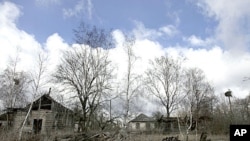Ira Khvostyk is home.
In the small Ukrainian village of Redkovka, her 92-year-old grandfather lives alone in his wooden farmhouse that was once home to three generations. For Khvostyk, the village, a three-hour bumpy drive from the capital, Kyiv, was a safe place where the world drifted by harmlessly until the Chernobyl nuclear accident happened.
"This was considered one of the central villages," she says pointing to a stretch of now abandoned homes. "It was home for me. Now I don’t even recognize it."
Khvostyk was 14 years old when the then world’s worst nuclear power plant explosion happened on April 26, 1986, in Chernobyl, just 35 kilometers from Redkovka. She remembers girls at school being asked to cover their heads and to stay at home. The school is closed now, just like most of the village.
At the time, Khvostyk, who is now 38 and works as a waitress in Kyiv, did not understand what was happening, or how much her life would change.
"I can't say I was scared, but my parents were. They understood what had happened," she says.
The explosion contaminated tens of thousands of square miles in northern Ukraine, southern Belarus and Russia’s Bryansk region. No one can be sure of the ultimate impact, but the damage done 25 years ago continues to take its toll.
Redkovka clearly suffered from high radiation levels, but villagers say it took dozens of complains to the local government and five years before an official measurement of the radiation dose was recorded.
"This only happened after the collapse of the Soviet Union," says Anatoli Kovalenko. He grew up in Redkovka and now maintains what is left of the village. "Of course, the government knew the village was contaminated, but they wanted to underplay the entire event. So they just ignored it."
For years, Soviet authorities withheld much information about Chernobyl - both from their own people and from the rest of the world. The Ukrainian government eventually classified Redkovka as a zone too dangerous for anyone to live in. Over the next two years, most of the villagers - about 1,000 people - abandoned their homes and resettled in a new town about an hour away.
Not far from Khvostyk’s former home, Lida and Mikhail Masanovitz, now both in their 70s, live with eight cats, 10 geese, a cow and two pigs in a rambling wooden house. They were both born in Redkovka, and never considered moving out after Chernobyl.
"We had just finished spring harvest that day. Then I heard about the accident," Lida Masanovitz says as she wipes tears off her deeply wrinkled face.
"I understood what had happened," she says. "I understood what Chernobyl would mean for us."
Despite the radiation risk, the Masanovitz family stayed. Lida maintains the local church - a piece of the village that has been restored since the collapse of the Soviet Union. Mikhail spends most of his day getting drunk on cheap vodka. It used to be a pastime with friends, but he’s now alone. The rest of the village is abandoned -- Redkovka is no longer on the map.
Ukrainian authorities say the 12 remaining villagers are here illegally.
"They had a choice, but they didn't want to leave," says Vladimir Udovichenko, mayor of Slavutich, a town built in the 1980s to house workers displaced by the accident at Chernobyl, about 20 minutes away. "It is misery in this village, but they want to finish their life in there."
Redkovka is one of scores of contaminated villages in Ukraine. Some are being revived 25 years after the Chernobyl nuclear reactor explosion. Some people say the radiation threat is overblown, and others feel that people claiming radiation-related diseases are seeking a government handout.
In all, more than 2.32 million people, including 452,000 children, have been hospitalized in Ukraine for illnesses blamed on the Chernobyl, according to the Health Ministry in Kyiv, which adds that those figures are only accurate through 2004.
Although some villages are getting new residents, Mayor Udovichenko says the end is in sight for Slavutich, due to its proximity to the Chernobyl reactor site. "When the villagers die," he says, "the village will no longer exist."
Watch a related video report by Zulima Palacio












